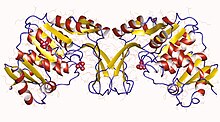| 1-phosphofructokinase | |||||||||
|---|---|---|---|---|---|---|---|---|---|
 Fructose 1-phosphate kinase homodimer, Bacillus halodurans Fructose 1-phosphate kinase homodimer, Bacillus halodurans | |||||||||
| Identifiers | |||||||||
| EC no. | 2.7.1.56 | ||||||||
| CAS no. | 37278-03-8 | ||||||||
| Databases | |||||||||
| IntEnz | IntEnz view | ||||||||
| BRENDA | BRENDA entry | ||||||||
| ExPASy | NiceZyme view | ||||||||
| KEGG | KEGG entry | ||||||||
| MetaCyc | metabolic pathway | ||||||||
| PRIAM | profile | ||||||||
| PDB structures | RCSB PDB PDBe PDBsum | ||||||||
| Gene Ontology | AmiGO / QuickGO | ||||||||
| |||||||||
In enzymology, 1-phosphofructokinase (EC 2.7.1.56) is an enzyme that catalyzes the chemical reaction
- ATP + D-fructose 1-phosphate → ADP + D-fructose 1,6-bisphosphate
Thus, the two substrates of this enzyme are ATP and D-fructose 1-phosphate, whereas its two products are ADP and D-fructose 1,6-bisphosphate. The enzyme was first described and characterized in the 1960s.
This enzyme belongs to the phosphofructokinase B (PfkB) or Ribokinase family of sugar kinases, specifically those transferring phosphorus-containing groups (phosphotransferases) with an alcohol group as acceptor. The systematic name of this enzyme class is ATP:D-fructose-phosphate 6-phosphotransferase. Other names in common use include fructose-1-phosphate kinase, 1-phosphofructokinase (phosphorylating), D-fructose-1-phosphate kinase, fructose 1-phosphate kinase, and 1-phosphofructokinase. This enzyme participates in fructose and mannose metabolism. The members of the PfkB/RK family are identified by the presence of three conserved sequence motifs and their enzymatic activity generally shows a dependence on the presence of pentavalent ions.
Structure
As of 2021, two structures have been solved for this class of enzymes, with the PDB accession codes 2JG5 and 2ABQ, both from structural genomics efforts. The protein is a homodimer.
References
- Reeves RE, Warren LG, Hsu DS (1966). "1-Phosphofructokinase from an anaerobe". J. Biol. Chem. 241 (6): 1257–61. doi:10.1016/S0021-9258(18)96768-2. PMID 4222878.
- Sapico V, Anderson RL (1969). "D-fructose 1-phosphate kinase and D-fructose 6-phosphate kinase from Aerobacter aerogenes. A comparative study of regulatory properties". J. Biol. Chem. 244 (22): 6280–8. doi:10.1016/S0021-9258(18)63534-3. PMID 4242639.
- ^ Park J, Gupta RS: Adenosine kinase and ribokinase--the RK family of proteins. Cell Mol Life Sci 2008, 65: 2875-2896.
- ^ Bork P, Sander C, Valencia A: Convergent evolution of similar enzymatic function on different protein folds: the hexokinase, ribokinase, and galactokinase families of sugar kinases. Protein Sci 1993, 2: 31-40.
- Maj MC, Singh B, Gupta RS: Pentavalent ions dependency is a conserved property of adenosine kinase from diverse sources: identification of a novel motif implicated in phosphate and magnesium ion binding and substrate inhibition. Biochemistry 2002, 41: 4059-4069.
| Transferases: phosphorus-containing groups (EC 2.7) | |||||||||||||||
|---|---|---|---|---|---|---|---|---|---|---|---|---|---|---|---|
| 2.7.1-2.7.4: phosphotransferase/kinase (PO4) |
| ||||||||||||||
| 2.7.6: diphosphotransferase (P2O7) | |||||||||||||||
| 2.7.7: nucleotidyltransferase (PO4-nucleoside) |
| ||||||||||||||
| 2.7.8: miscellaneous |
| ||||||||||||||
| 2.7.10-2.7.13: protein kinase (PO4; protein acceptor) |
| ||||||||||||||
| Enzymes | |
|---|---|
| Activity | |
| Regulation | |
| Classification | |
| Kinetics | |
| Types |
|